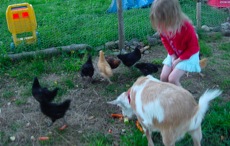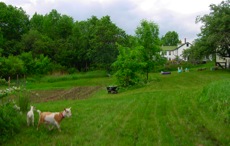
Organic farming

Our Farm
Goats- 1 Nigerian Dwarf wether,1 Nigerian/Cashmere cross
Chickens- 24 hens 2 roosters
Australorps- -6 hens 1 rooster
Buff Orpingtons- 6
Aracauna- 5
Partridge Rock- 6
Andalusian- Rooster- 1

contact
Email:
Instant Messaging: farmercheri-AOL IM
Groups: 

Our Favorites
Books: Backyard in your Barnyard,
Writers:
Farm News-
Food:
All Natural

Update Winter 06/07
Our first winter with farm animals has gone pretty well. Our goats are starting to get pretty bored, but they are tough little buggers and nestle down side by side to keep warm and cozy. They don’t like the snow at all. Won’t let their little footies touch the stuff. The chickens are the same. Wendy is half ‘cashmere goat’ and she had a much thicker and warmer coat than Calvin did. Poor boy. He’s designed for Africa. We’re starting to think about adding some new barnyard friends, but not sure which ones yet. We’ll keep you posted, and I realized I don’t have any pics of our sweet lil bunny up...I’ll have to got track her down in the barn...she has decided to live on our farm and allow snuggles and love, but no cages for her. She lives freely and comes and goes as she pleases. (she comes for the bunny food and heat lamp ) She’s the only one who didn’t mind the snow...and she gets in and out of the barn on her own because bunnies can dig lil holes and go where ever they please. So, ‘who’s the smartest barn yard critter?’ The bunny.
There are plenty of reasons we got the farming itch. To be self reliant, to save money, to have fresh, organic produce and eggs. To let our kids grow up in a natural farm environment. On and on. When the plan started into action I started with the usual online searches and book searches for each of the critters we were interested in raising. I was pretty surprised at how few sites were related to raising farm animals in as natural a way as possible. So many small farms rely on some very big agri business practices, like medicating their animals or keeping them in cages or penned in small areas with little to do or eat. We knew from the start we didn’t want that. We wanted happy farm creatures who could live as naturally as possible, and so far so good. They are provided with roomy indoor areas to sleep at night or retreat from the elements in the day. They have an outdoor pen with plenty of grass and other yummy stuff to nibble. They even have play structures and perches to keep them occupied. We’ve been documenting our experiences with plenty of pictures and video. I’ve been sorting through web sites and ordering and reading books. We’ll add fun stuff that we learn as we go along.
Happy organic farming!






